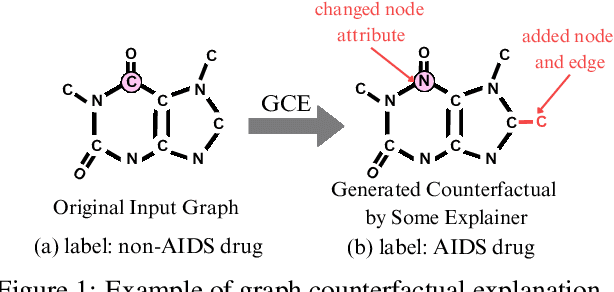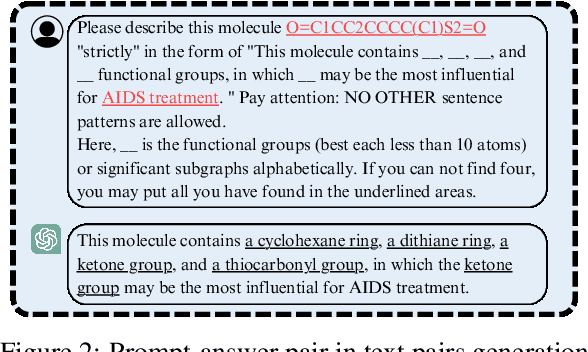Yinhan He
Virtual Nodes Can Help: Tackling Distribution Shifts in Federated Graph Learning
Dec 26, 2024Abstract:Federated Graph Learning (FGL) enables multiple clients to jointly train powerful graph learning models, e.g., Graph Neural Networks (GNNs), without sharing their local graph data for graph-related downstream tasks, such as graph property prediction. In the real world, however, the graph data can suffer from significant distribution shifts across clients as the clients may collect their graph data for different purposes. In particular, graph properties are usually associated with invariant label-relevant substructures (i.e., subgraphs) across clients, while label-irrelevant substructures can appear in a client-specific manner. The issue of distribution shifts of graph data hinders the efficiency of GNN training and leads to serious performance degradation in FGL. To tackle the aforementioned issue, we propose a novel FGL framework entitled FedVN that eliminates distribution shifts through client-specific graph augmentation strategies with multiple learnable Virtual Nodes (VNs). Specifically, FedVN lets the clients jointly learn a set of shared VNs while training a global GNN model. To eliminate distribution shifts, each client trains a personalized edge generator that determines how the VNs connect local graphs in a client-specific manner. Furthermore, we provide theoretical analyses indicating that FedVN can eliminate distribution shifts of graph data across clients. Comprehensive experiments on four datasets under five settings demonstrate the superiority of our proposed FedVN over nine baselines.
Graph Neural Networks Are More Than Filters: Revisiting and Benchmarking from A Spectral Perspective
Dec 10, 2024Abstract:Graph Neural Networks (GNNs) have achieved remarkable success in various graph-based learning tasks. While their performance is often attributed to the powerful neighborhood aggregation mechanism, recent studies suggest that other components such as non-linear layers may also significantly affecting how GNNs process the input graph data in the spectral domain. Such evidence challenges the prevalent opinion that neighborhood aggregation mechanisms dominate the behavioral characteristics of GNNs in the spectral domain. To demystify such a conflict, this paper introduces a comprehensive benchmark to measure and evaluate GNNs' capability in capturing and leveraging the information encoded in different frequency components of the input graph data. Specifically, we first conduct an exploratory study demonstrating that GNNs can flexibly yield outputs with diverse frequency components even when certain frequencies are absent or filtered out from the input graph data. We then formulate a novel research problem of measuring and benchmarking the performance of GNNs from a spectral perspective. To take an initial step towards a comprehensive benchmark, we design an evaluation protocol supported by comprehensive theoretical analysis. Finally, we introduce a comprehensive benchmark on real-world datasets, revealing insights that challenge prevalent opinions from a spectral perspective. We believe that our findings will open new avenues for future advancements in this area. Our implementations can be found at: https://github.com/yushundong/Spectral-benchmark.
Global Graph Counterfactual Explanation: A Subgraph Mapping Approach
Oct 25, 2024



Abstract:Graph Neural Networks (GNNs) have been widely deployed in various real-world applications. However, most GNNs are black-box models that lack explanations. One strategy to explain GNNs is through counterfactual explanation, which aims to find minimum perturbations on input graphs that change the GNN predictions. Existing works on GNN counterfactual explanations primarily concentrate on the local-level perspective (i.e., generating counterfactuals for each individual graph), which suffers from information overload and lacks insights into the broader cross-graph relationships. To address such issues, we propose GlobalGCE, a novel global-level graph counterfactual explanation method. GlobalGCE aims to identify a collection of subgraph mapping rules as counterfactual explanations for the target GNN. According to these rules, substituting certain significant subgraphs with their counterfactual subgraphs will change the GNN prediction to the desired class for most graphs (i.e., maximum coverage). Methodologically, we design a significant subgraph generator and a counterfactual subgraph autoencoder in our GlobalGCE, where the subgraphs and the rules can be effectively generated. Extensive experiments demonstrate the superiority of our GlobalGCE compared to existing baselines. Our code can be found at https://anonymous.4open.science/r/GlobalGCE-92E8.
Explaining Graph Neural Networks with Large Language Models: A Counterfactual Perspective for Molecular Property Prediction
Oct 19, 2024



Abstract:In recent years, Graph Neural Networks (GNNs) have become successful in molecular property prediction tasks such as toxicity analysis. However, due to the black-box nature of GNNs, their outputs can be concerning in high-stakes decision-making scenarios, e.g., drug discovery. Facing such an issue, Graph Counterfactual Explanation (GCE) has emerged as a promising approach to improve GNN transparency. However, current GCE methods usually fail to take domain-specific knowledge into consideration, which can result in outputs that are not easily comprehensible by humans. To address this challenge, we propose a novel GCE method, LLM-GCE, to unleash the power of large language models (LLMs) in explaining GNNs for molecular property prediction. Specifically, we utilize an autoencoder to generate the counterfactual graph topology from a set of counterfactual text pairs (CTPs) based on an input graph. Meanwhile, we also incorporate a CTP dynamic feedback module to mitigate LLM hallucination, which provides intermediate feedback derived from the generated counterfactuals as an attempt to give more faithful guidance. Extensive experiments demonstrate the superior performance of LLM-GCE. Our code is released on https://github.com/YinhanHe123/new\_LLM4GNNExplanation.
Causal Inference with Latent Variables: Recent Advances and Future Prospectives
Jun 20, 2024Abstract:Causality lays the foundation for the trajectory of our world. Causal inference (CI), which aims to infer intrinsic causal relations among variables of interest, has emerged as a crucial research topic. Nevertheless, the lack of observation of important variables (e.g., confounders, mediators, exogenous variables, etc.) severely compromises the reliability of CI methods. The issue may arise from the inherent difficulty in measuring the variables. Additionally, in observational studies where variables are passively recorded, certain covariates might be inadvertently omitted by the experimenter. Depending on the type of unobserved variables and the specific CI task, various consequences can be incurred if these latent variables are carelessly handled, such as biased estimation of causal effects, incomplete understanding of causal mechanisms, lack of individual-level causal consideration, etc. In this survey, we provide a comprehensive review of recent developments in CI with latent variables. We start by discussing traditional CI techniques when variables of interest are assumed to be fully observed. Afterward, under the taxonomy of circumvention and inference-based methods, we provide an in-depth discussion of various CI strategies to handle latent variables, covering the tasks of causal effect estimation, mediation analysis, counterfactual reasoning, and causal discovery. Furthermore, we generalize the discussion to graph data where interference among units may exist. Finally, we offer fresh aspects for further advancement of CI with latent variables, especially new opportunities in the era of large language models (LLMs).
Spectral Greedy Coresets for Graph Neural Networks
May 27, 2024Abstract:The ubiquity of large-scale graphs in node-classification tasks significantly hinders the real-world applications of Graph Neural Networks (GNNs). Node sampling, graph coarsening, and dataset condensation are effective strategies for enhancing data efficiency. However, owing to the interdependence of graph nodes, coreset selection, which selects subsets of the data examples, has not been successfully applied to speed up GNN training on large graphs, warranting special treatment. This paper studies graph coresets for GNNs and avoids the interdependence issue by selecting ego-graphs (i.e., neighborhood subgraphs around a node) based on their spectral embeddings. We decompose the coreset selection problem for GNNs into two phases: a coarse selection of widely spread ego graphs and a refined selection to diversify their topologies. We design a greedy algorithm that approximately optimizes both objectives. Our spectral greedy graph coreset (SGGC) scales to graphs with millions of nodes, obviates the need for model pre-training, and applies to low-homophily graphs. Extensive experiments on ten datasets demonstrate that SGGC outperforms other coreset methods by a wide margin, generalizes well across GNN architectures, and is much faster than graph condensation.
Safety in Graph Machine Learning: Threats and Safeguards
May 17, 2024Abstract:Graph Machine Learning (Graph ML) has witnessed substantial advancements in recent years. With their remarkable ability to process graph-structured data, Graph ML techniques have been extensively utilized across diverse applications, including critical domains like finance, healthcare, and transportation. Despite their societal benefits, recent research highlights significant safety concerns associated with the widespread use of Graph ML models. Lacking safety-focused designs, these models can produce unreliable predictions, demonstrate poor generalizability, and compromise data confidentiality. In high-stakes scenarios such as financial fraud detection, these vulnerabilities could jeopardize both individuals and society at large. Therefore, it is imperative to prioritize the development of safety-oriented Graph ML models to mitigate these risks and enhance public confidence in their applications. In this survey paper, we explore three critical aspects vital for enhancing safety in Graph ML: reliability, generalizability, and confidentiality. We categorize and analyze threats to each aspect under three headings: model threats, data threats, and attack threats. This novel taxonomy guides our review of effective strategies to protect against these threats. Our systematic review lays a groundwork for future research aimed at developing practical, safety-centered Graph ML models. Furthermore, we highlight the significance of safe Graph ML practices and suggest promising avenues for further investigation in this crucial area.
 Add to Chrome
Add to Chrome Add to Firefox
Add to Firefox Add to Edge
Add to Edge